 He lived in a box of a home in a Honduran mountain village. He slept in a room partitioned by wood and plastic just like his brothers and sisters.
He lived in a box of a home in a Honduran mountain village. He slept in a room partitioned by wood and plastic just like his brothers and sisters.
His father farmed beans and corn. His mother was the only teacher in the roadless village of Plazuelas. It took over two hours to hike up the mountain from the nearest bus stop.
He grew up around ten families scattered half a mile between each other.
It was uncommon to make it to sixth grade in his village, Hermes Machado said.
His mother did, and so did Machado.
“Education can change someone’s life like it did me,” Machado said, who is currently 27 and the principal of a bilingual elementary school.
I have always been a busy guy, he said.
For me, I didn’t just want to marry young and farm corn and beans, he said. I like to think outside the box.
On the weekends he works toward his master’s degree in education. He also enjoys working as a translator with different groups, he said.
This week, he is working with Belmont University and Middle Tennessee University in the town of Cane, Honduras. As an English speaker, he doesn’t miss a beat.
He jokes in a bus full of Americans: You have horny cows in America right?
A women laughs and check to see if he is joking. Machado has mastered the art of poking fun, which puts the group at ease. He understands culture past the village of his youth and past the borders of his country.

On a three-month fundraising trip to America, he saw the urban lights of New York City. He rode the rides at Disney World, saw the St. Louis Arch and saw the Statue of Liberty.
People wanted me to see everything, he said.
Machado tells stories of his adventures like a standup comedian, picking up on cultural nuances.
I couldn’t just call people to hangout, he said. I had to call and plan it out like a week in advance.
He told a story about being dragged to shop the day after Thanksgiving.
Women laid out advertisements on the floor, mapping out deals the night before, he said. They woke me up at 3 a.m. In the packed store, a woman with a shopping cart was behind me. The woman asked…
Machado snarls his face as he gets into character.
“Are you going to move so I can get by?”
His education goes beyond the classroom.
In the mornings, he takes a taxi to work for 15 lempiras, for less than a dollar.
He arrives at the school he oversees after a 5-minute ride in a white and blue-striped taxi.
The backdrop is a steep line of mountains cutting into the sky. Their distance creates a blue mist, and clouds visit to dabble at the peaks.
Machado has visited these mountains with friends to get away. There are waterfalls, old trees, and fruit, he said. He enjoys walking through protected forests when he has spare time, he said.
The road leading to the school is parallel to the line of mountains. Enlaces is a private Christian school with just shy of a hundred students. English and Spanish is taught in the classrooms. Through the years, Enlaces has grown. Today, it is primarily a youth center, church and humanitarian distribution center.
After school each day, students can attend the youth center at Enlaces.
Every hour we share the gospel in some way for five minutes, Machado said. Machado became a Christian after talking with missionaries from Ohio when he was 19.
“They shared mainly by how they lived,” Machado said.
They answered my questions when I asked, he said. Now I like to give back by translating for other groups.
“Enlaces” means connection or bridge in English, Machado said.
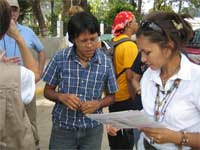 During Hurricane Mitch in the late ‘90s, Enlaces served as a shelter for 400 to 500 people, he said.
During Hurricane Mitch in the late ‘90s, Enlaces served as a shelter for 400 to 500 people, he said.
Five to seven semi trucks of supplies still arrive at Enlaces each year. Clothes, food and medicine are sent to area hospitals, orphanages and organizations.
You open the back of the truck and the supplies are literally bulging out, Machado said.
Machado was hired to set up the school two years ago. In his early 20s, Machado had already helped set up a school with an American and two Britains.
Enlaces doesn’t meet on Mondays.
There was some opposition to this innovation, but I thought it was better, Machado said. I am often doing homework for my graduate studies on my day off.
Students at his school pay around $50 a month to attend, but 16 students are offered full scholarships, he said.
Education seems to run in the family. Machado’s 17-year-old brother, Pedro, wants to be a lawyer, Pedro said. He graduates this month from high school, and he is by Machado’s side this week as an interpreter.
When Machado’s mother was just a child, she woke at 3 a.m. everyday. She sold tortillas in the market to support her grandmother. Then she returned to her village before noon to attend school till 5 p.m.
She did her homework after school and then prepared tortillas for the next day, boiling and grinding the corn.
My mother continued to attend school when others dropped out because she knew it was better than selling tortillas, Machado said.
After she completed 6th grade, she became a teacher and married Machado’s father when she was 15. Machado was the third child of six in this family.
When Machado was 15, his mother searched for a job so her children could get an education past elementary school. They moved to the town of Comayagua, Machado said.
One day Machado wants to hike that two hours to his birth village of Plazuelas.
He has been too busy, he said. The village has probably grown a lot. Most of the youth in his village didn’t make it to 6th grade and they probably have raised new families now, he said.
 At the student newspaper over here at Belmont, we just finished the online package about the Honduras Trip.
At the student newspaper over here at Belmont, we just finished the online package about the Honduras Trip.
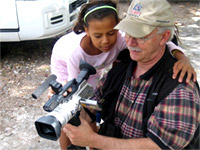 Music of the Big Band era surrounded my childhood. One of those old standards,
Music of the Big Band era surrounded my childhood. One of those old standards, 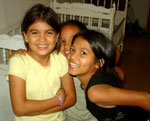
 After reading Chansin's
After reading Chansin's 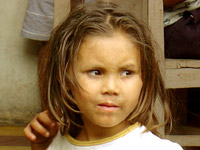 The three-day weekend provided me my first good opportunity to organize digital stills into something that makes sense. Today, I posted
The three-day weekend provided me my first good opportunity to organize digital stills into something that makes sense. Today, I posted  When I was younger, I made plans to save the world. Why don’t the rich people just give a percent of their money to the poor throughout the world, I’d ask a friend at school.
When I was younger, I made plans to save the world. Why don’t the rich people just give a percent of their money to the poor throughout the world, I’d ask a friend at school. The letters weren’t even written to her, but they changed her life forever.
The letters weren’t even written to her, but they changed her life forever. 
 I have shot over a thousand pictures in Honduras with my digital camera. Each night I upload my memory cards to my computer and scroll through the shots.
I have shot over a thousand pictures in Honduras with my digital camera. Each night I upload my memory cards to my computer and scroll through the shots.
 There are numerous poverty-stricken families in Cane, Honduras. In a particular family of seven, only one of the little ones goes to school. He is seven years old. In a year or two he will have to drop out of school and begin working.
There are numerous poverty-stricken families in Cane, Honduras. In a particular family of seven, only one of the little ones goes to school. He is seven years old. In a year or two he will have to drop out of school and begin working.  The six children had nothing, and all I could give them were candy canes. I felt stupid for giving them candy when I could see their poverty and see they needed so much more.
The six children had nothing, and all I could give them were candy canes. I felt stupid for giving them candy when I could see their poverty and see they needed so much more.  Every member of our team has a camera. Not every member of our team has a degree in photography or the professional equipment to go with it...but one person has both. Matt Chenoweth's assignment on this trip is to capture the people, the places, and the mission efforts of the rest of the team. There are print production and presentation needs for the KidSake Foundation that will benefit from high quality film. Matt would be the first to tell you that he is much more comfortable with traditional film than he is with a file from a digital camera. The bad news for readers of Reporting from Honduras is that none of the images that Matt shot this week will appear electronically until he returns to the US for a marathon session of film processing and digitizing.
Every member of our team has a camera. Not every member of our team has a degree in photography or the professional equipment to go with it...but one person has both. Matt Chenoweth's assignment on this trip is to capture the people, the places, and the mission efforts of the rest of the team. There are print production and presentation needs for the KidSake Foundation that will benefit from high quality film. Matt would be the first to tell you that he is much more comfortable with traditional film than he is with a file from a digital camera. The bad news for readers of Reporting from Honduras is that none of the images that Matt shot this week will appear electronically until he returns to the US for a marathon session of film processing and digitizing. He lived in a box of a home in a Honduran mountain village. He slept in a room partitioned by wood and plastic just like his brothers and sisters.
He lived in a box of a home in a Honduran mountain village. He slept in a room partitioned by wood and plastic just like his brothers and sisters.
 During Hurricane Mitch in the late ‘90s, Enlaces served as a shelter for 400 to 500 people, he said.
During Hurricane Mitch in the late ‘90s, Enlaces served as a shelter for 400 to 500 people, he said.  We thought we had little in common.
We thought we had little in common.  By Nathan Baker and Chansin Bird
By Nathan Baker and Chansin Bird In Honduras I drank Coke from a straw inserted into a tied off bag. I have bought a half liter of water for a dime and half a penny, or 2 lempiras. The water was in a bag.
In Honduras I drank Coke from a straw inserted into a tied off bag. I have bought a half liter of water for a dime and half a penny, or 2 lempiras. The water was in a bag. Our group went to a school in Cane to paint the walls. A group of kids waited at the door to help. At first they seemed angelic, images on a TV. A smile of a young girl still haunts me—the purity in her eyes.
Our group went to a school in Cane to paint the walls. A group of kids waited at the door to help. At first they seemed angelic, images on a TV. A smile of a young girl still haunts me—the purity in her eyes.
 I have never been so comfortable around prisoners before.
I have never been so comfortable around prisoners before. 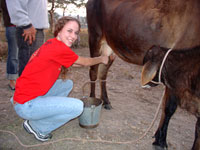 File this under the "Oh, I forgot to warn you" category: Early moring milking in Cane, Honduras is a process that includes a 30+ minute hike across a rocky plane...without any light other than the sunrise peeking from behind a mountain range. Monday's award for moving way beyond the 'journalistic comfort zone' goes to Chansin who discovered that what dairy farmers do on the business end of a milk cow isn't as easy as farmers make it look. The answer to 'why were we up at 5:00AM to capture milking pictures?', is a story that is ends around dusk with a block of cheese. Part of today's adventure was filling in the story gaps between the pasture and the cheese press.
File this under the "Oh, I forgot to warn you" category: Early moring milking in Cane, Honduras is a process that includes a 30+ minute hike across a rocky plane...without any light other than the sunrise peeking from behind a mountain range. Monday's award for moving way beyond the 'journalistic comfort zone' goes to Chansin who discovered that what dairy farmers do on the business end of a milk cow isn't as easy as farmers make it look. The answer to 'why were we up at 5:00AM to capture milking pictures?', is a story that is ends around dusk with a block of cheese. Part of today's adventure was filling in the story gaps between the pasture and the cheese press.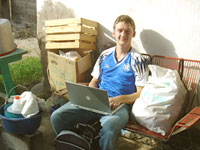
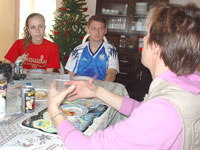
 What a party!
What a party!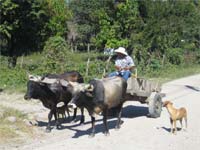 Roosters rule the night in Cane, Honduras.
Roosters rule the night in Cane, Honduras.  The pilot of the 757 has autopilot disengaged over these Honduras hills. He dips into a firm spiral above Tegucigalpa on New Year’s Day, 2006, then lands. A group from Belmont University and Middle Tennessee State University step off the plane. Their first few steps are down stairs, made mobile by a bright blue truck shinning from the heat.
The pilot of the 757 has autopilot disengaged over these Honduras hills. He dips into a firm spiral above Tegucigalpa on New Year’s Day, 2006, then lands. A group from Belmont University and Middle Tennessee State University step off the plane. Their first few steps are down stairs, made mobile by a bright blue truck shinning from the heat. Jette Halladay, who teaches theatre at MTSU, jumps in and echos Jenny’s thoughts regarding the physical details of the structure. Fellow professors Kimberly Dummons and Maggie Fontanasi-Sieme also sit in the petite yet polished den.
Jette Halladay, who teaches theatre at MTSU, jumps in and echos Jenny’s thoughts regarding the physical details of the structure. Fellow professors Kimberly Dummons and Maggie Fontanasi-Sieme also sit in the petite yet polished den. When cameras click and flash, Clementina smiles at the person, not the camera.
When cameras click and flash, Clementina smiles at the person, not the camera. After speaking with Jenny Rogers, The KidSAKE Foundation executive director, the following are some of the goals of this trip and the future of The KidSAKE Foundation, as I understand it:
After speaking with Jenny Rogers, The KidSAKE Foundation executive director, the following are some of the goals of this trip and the future of The KidSAKE Foundation, as I understand it: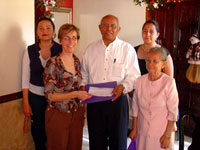 The full eight member teams and all the luggage arrived safely in Tegucigalpa. Somehow, that doesn't seem newsworthy but it is at least worthy of one large, collective, sigh of relief. We have been blessed with beautiful weather, a patient translator, people who seem to want to feed us at every turn, and reliable transportation. It would be easy to become overwhelmed with the crowds and unfamiliar surroundings, but all are handling things well. Nate and Chansin have taken notes all day and will post stories as soon as we have a little breathing room in the schedule.
The full eight member teams and all the luggage arrived safely in Tegucigalpa. Somehow, that doesn't seem newsworthy but it is at least worthy of one large, collective, sigh of relief. We have been blessed with beautiful weather, a patient translator, people who seem to want to feed us at every turn, and reliable transportation. It would be easy to become overwhelmed with the crowds and unfamiliar surroundings, but all are handling things well. Nate and Chansin have taken notes all day and will post stories as soon as we have a little breathing room in the schedule.